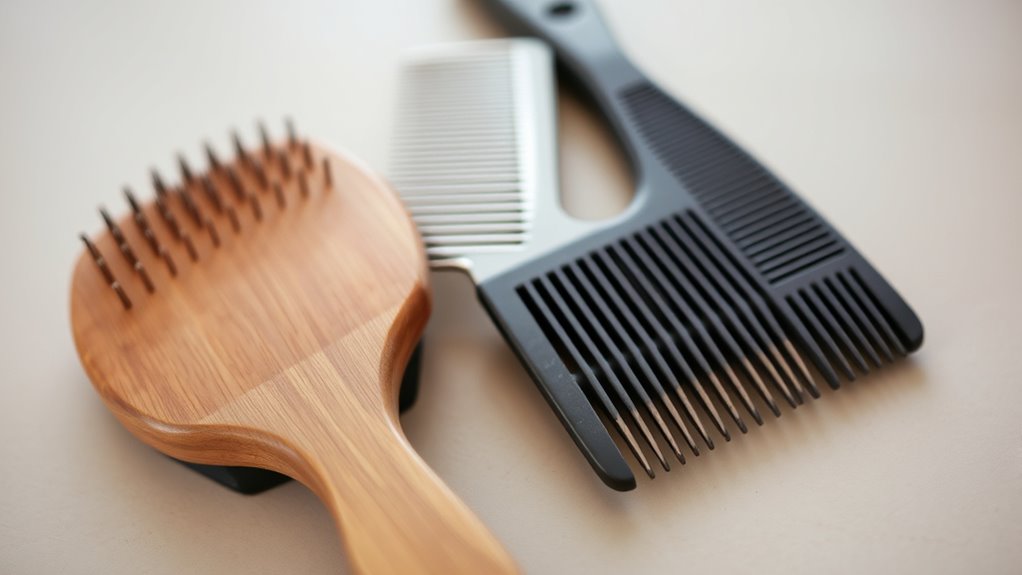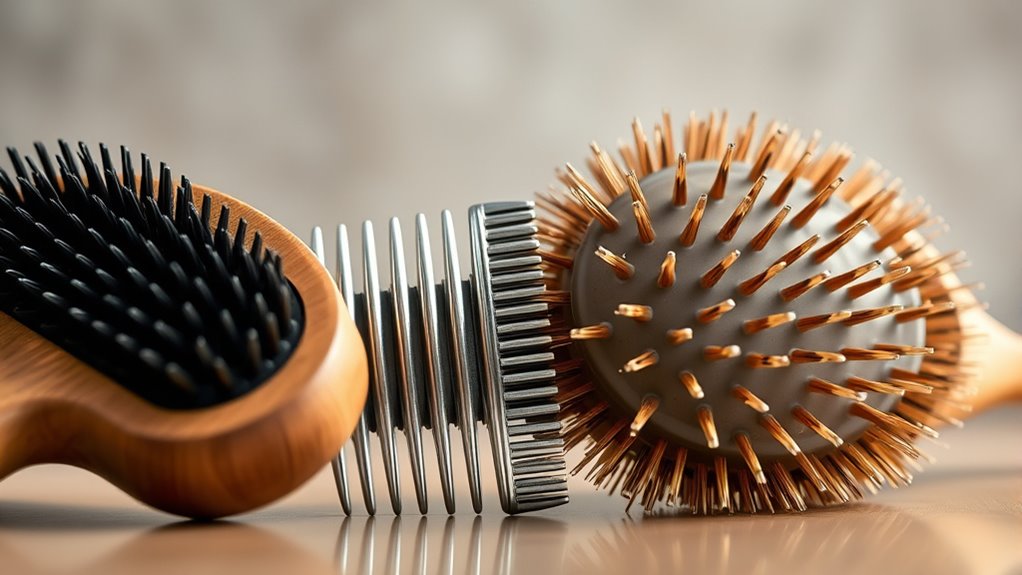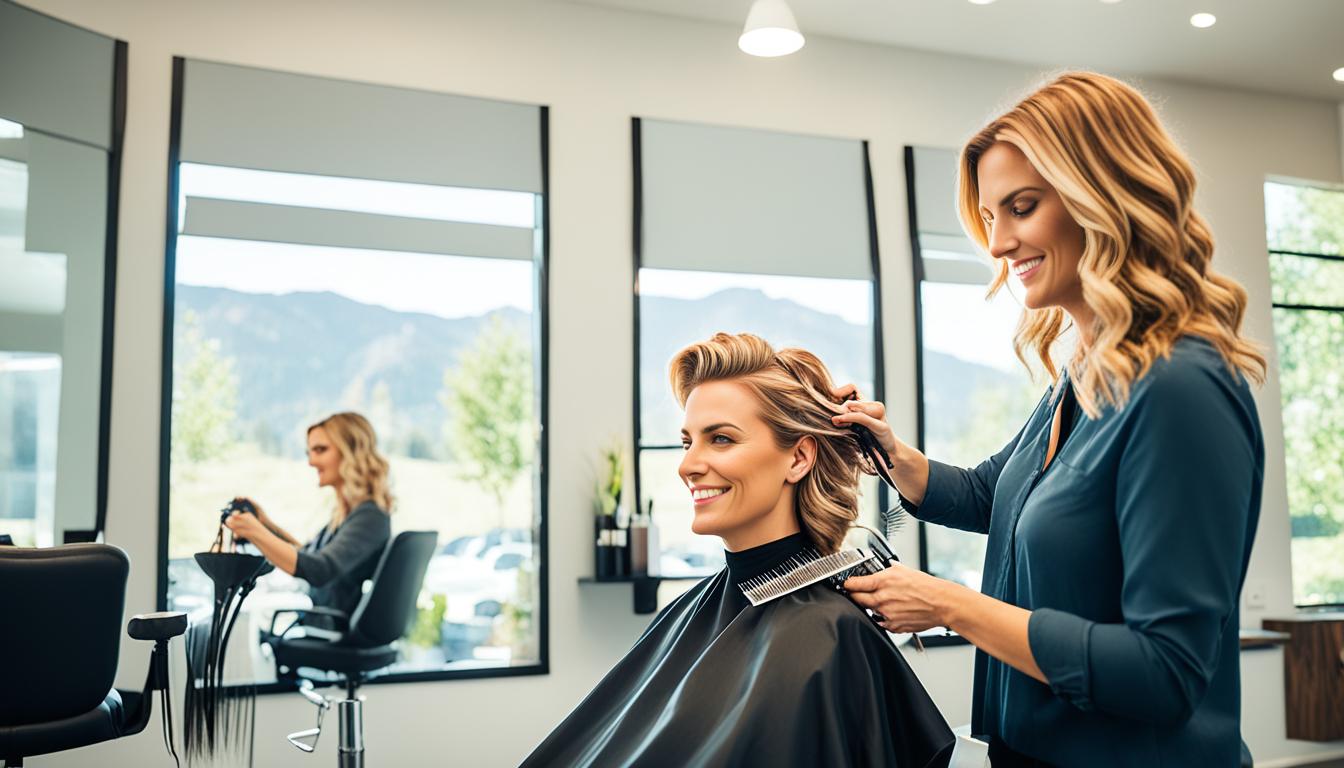Choosing the right brushes and combs makes a big difference for your hair’s health and manageability. Wide-tooth combs gently detangle wet or curly hair without breakage, while paddle brushes smooth and add shine to straight hair. Scalp brushes stimulate blood flow and promote growth, and round brushes help style and add volume. Each tool serves a specific purpose—selecting the right one can keep your hair healthier and easier to style. Discover more about how each tool works for your hair.
Key Takeaways
- Wide-tooth combs gently detangle wet or curly hair, reducing breakage and maintaining curl pattern.
- Paddle brushes with flexible bristles smooth hair and distribute natural oils for added shine.
- Round brushes are ideal for styling and creating volume, especially on straight or layered hair.
- Scalp brushes with rounded tips stimulate blood flow and promote healthy hair growth.
- Fine or thin hair benefits from lightweight, gentle brushes, while thicker hair needs sturdier, denser-bristled tools.

Have you ever wondered why choosing the right brush or comb makes such a difference in your hair care routine? The tools you pick can influence how easily your hair detangles, how healthy your scalp stays, and how shiny your hair looks. Different tools serve different purposes, and understanding their roles helps you take better care of your hair every day.
Choosing the right hair tools enhances detangling, scalp health, and shine for healthier, more manageable hair.
When it comes to hair detangling, your choice of brush or comb can make all the difference. For example, wide-tooth combs are excellent for gently loosening knots without causing breakage, especially on wet hair. They help you work through tangles smoothly, reducing frustration and damage. If you prefer brushes, choose one with flexible bristles, like a paddle brush with rounded tips, which glides through hair without pulling or snagging. Regularly detangling with the right tool keeps your hair smooth and prevents split ends from forming. It also minimizes breakage, making your hair look healthier and more manageable over time.
Scalp stimulation is another key aspect where your tools matter. Massaging your scalp with a gentle brush or comb can boost blood flow, which encourages healthy hair growth. Soft-bristled brushes or scalp brushes with rounded tips are ideal for this purpose. They stimulate the scalp without scratching or irritating the skin. When you regularly incorporate scalp stimulation into your routine, you help distribute natural oils from your roots to the ends, promoting shine and moisture retention. Plus, this stimulation can be relaxing, turning your hair care time into a soothing ritual. The right tool makes it easier to reach all areas of your scalp, ensuring you get the benefits of increased circulation and oil distribution.
Choosing the right brush or comb also depends on your hair type. Fine or thin hair benefits from gentle, lightweight tools that avoid adding weight or causing breakage. Thicker or curly hair might need sturdier brushes with densely packed bristles that can handle the texture and help define curls. If you have curly hair, a wide-tooth comb is typically better for detangling without disrupting your natural curl pattern. Meanwhile, straight hair often responds well to paddle brushes or round brushes for styling and smoothing. Additionally, incorporating a variety of tools into your routine can enhance your hair health by catering to different styling needs and hair textures.
In the end, the tools you select should match your hair type and your specific needs—whether it’s detangling, scalp stimulation, or styling. Using the right brush or comb not only makes your routine easier but also supports healthier, stronger hair. When you pay attention to which tool works best, you’re investing in the long-term health and beauty of your hair.
Frequently Asked Questions
How Often Should I Replace My Hairbrush or Comb?
You should replace your hairbrush or comb every six months to maintain good hairbrush maintenance and comb longevity. Over time, hair products, oils, and debris build up, reducing their effectiveness and potentially damaging your hair. Regular cleaning helps, but if you notice frayed bristles, cracks, or buildup that won’t come off, it’s time for a new one. Doing this guarantees healthy hair and a tidy scalp.
Can I Use the Same Brush for Wet and Dry Hair?
Sure, go ahead and use the same brush for wet and dry hair—sarcastically, of course. In reality, it’s best to keep different brushes for wet and dry hair to prevent damage and bacterial buildup. Consider your hair type compatibility and brush material considerations; plastic brushes can cause more static and breakage when used wet, while natural bristles are gentler on dry hair. Switching brushes helps maintain healthy hair and scalp.
Are There Specific Brushes for Curly Versus Straight Hair?
Yes, there are specific brushes for curly hair and straight hair combs. For curly hair, you should use curly hair brushes that help define curls and reduce frizz, like wide-tooth brushes. For straight hair, straight hair combs or fine-tooth combs work best to detangle and smooth without causing breakage. Using the right tool for your hair type makes styling easier and keeps your hair healthier.
What Materials Are Best for Gentle Scalp Massage?
For gentle scalp massage, opt for soft-bristled brushes made of natural materials like boar hair or silicone. These materials promote scalp stimulation without causing irritation. Use gentle brushing techniques to increase blood flow and relax your scalp. Avoid harsh or stiff brushes, as they can damage your skin. Regular, gentle massaging with suitable materials helps improve scalp health and enhances your overall hair condition.
How Do I Clean and Disinfect My Brushes and Combs Properly?
Start by soaking your brushes and combs in a solution of warm water and gentle shampoo or dish soap. For disinfectant options, create a DIY cleaning mix with vinegar and water or use rubbing alcohol. Swish them around, then scrub with an old toothbrush to remove residue. Rinse thoroughly, dry completely, and you’ll keep your tools clean, safe, and shining, preventing build-up and bacteria.
Conclusion
Just like a trusted sword and shield in a hero’s journey, your brushes and combs are your hair’s best allies. Use the right tool for each task, and your hair will thank you with shine and health. Remember, even Cinderella needed her glass slipper—choose your tools wisely, and you’ll uncover beauty’s magic. With a little care, you’ll turn everyday grooming into a fairy tale of self-love and confidence.










